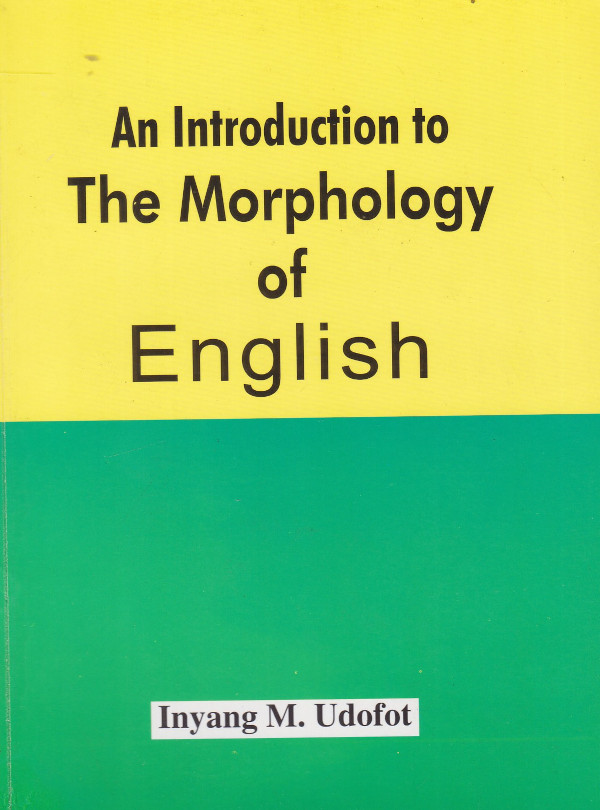An Introduction to the Morphology of English
$5.00
ISBN: 978-2275-30-1
ABOUT THE BOOK
An introduction to the Morphology of English presents the generally accepted facts on English word formation. lt
explains and illustrates the basic concepts and units of English word formation; important word building
processes and loan words that have come into English through contacts and conquest including nativised and
coined words from the New Englishes. The approach is largely introductory and assumes no previous knowledge
of English word formation. Consequently, the book is easily accessible to both beginning and advanced students of English Language and Linguistics as well as the general and exercises are included to help the student to practice the concepts explained as well as increase his vocabulary, and the teacher to evaluate his student
PREFACE
This book presents the generally accepted facts on English word formation in the tradition of textbook writing. It explains basic morphological concepts on English word formation processes. The approach is largely introductory and assumes no previous knowledge of English word formation with the result that the book is easily accessible to beginning
students of English Language and Linguistics at the tertiary level as well as the general reader. The activities and exercises are meant to help the student to increase his vocabulary and the teacher to evaluate his students.
The first two chapters deal with introductory matters. They present the basic concepts and units of English word formation. Chapters Three and Four deal with the most important word building processes in English: affixation and compounding. These chapters would also be useful to students at the senior secondary school level. Chapter Five examines
the concept of productivity and creativity. It explains why some potential words are disallowed in English. The appendix is a useful addition to the book. It gives a historical sketch of loan words that have come into English through contact and conquest including nativised and coined words from the new Englishes. It is also a useful source on the milestones
of the history of the development of English. Iam thankful to the members of my immediate family for their love and support which have given me the atmosphere for this work. I also thank my students whose expressed need motivated me to undertake the writing of this book. I take responsibility for any blemish that the work contains.
Prof. Inyang M. Udofot (Ph. D)
Department of English
University of Uyo, Uyo
1999, 2010
Description
CONTENTS
Dedication
Preface
CHAPTER ONE: BASIC CONCEPTS
1.1 Morphology
1.2 The morph, the morpheme and the allomorph
1.20 The morph
1.21 The morpheme
1.22. The allomorph
1.3. Allomorphic variations
1.3.1 Z1 or Plural morpheme
1.3.2 Z2 or Possessive morpheme
1.2.3 Z3 or Concord morpheme
1.3.4 D or Past tense morpheme
1.4 Grammatical and Lexical conditioning
1.5 Morphpohonemics, morphosyntactics and morphosemantics
Exercises
CHAPTER TWO: THE NATURE OF THE MORPHEME
2.1 The morpheme and the syllable
2.2 The morpheme and the phoneme
2.3 Types of morphemes
2.3.1 Free and Bound morphemes
2.3.2 Roots, Stems and Bases
2.4 Morphological types
2.5 Syntagmatic Relations and Segmentibility
2.6 The English Word
Exercises
CHAPTER THREE: AFFIXATION
3.1 Affixes
3.2 Prefixation
3:3 Suffixation
3.4 Inflectional and Derivational Morphemes
3.4.1 Inflectional morphemes
3.4.2 Derivational morphemes
3.5 Multiple affixation
3.6 Zero Affixation or Conversation
3.7 Neutral and Non- neutral Affixes Exercises
CHAPTER FOUR: Compounding
4.1 Compounds
4.2 The Nature of Compounds
4.2.1 Compounds and Phonology
4.2.2 Compounds and Syntax
4.2.2.1 Endocentric compounds
4.2.2.2 Exocentric Compounds
4.2.2.3 Copulative Compounds
4.3. Compounds and Derivation
4.31 Cranberry Compounds
4.32 Neo-classical Compounds
4.4. Idioms and Compounds
Exercises
CHAPTER FIVE: PRODUCTIVITY AND
CREATIVITY IN ENGLISH
WORD FORMATION
5.1 Existing and Potential Words
5.2 Productivity
5.3 Productivity and Phonotactic Constraints
5.3.1 Blocking
5.3.1.1 Phonological Factors
5.3.1.2 Morphological Factors
5.3.1.3 Semantics Factors
5.4 Productivity and Creativity
5.4.1 Neologisms
5.4.2 Creativity and Contact Situations
5.4.3 Clipping
5.4.4 Blending
5.4.5 Acronymy
Exercises
APPENDIX: BORROWING: A HISTORICAL SKETCH
A.1 The Anglo-Saxons and Latin Words
A.2 Old English and Norse Loan Words
A.3 Middle English and French Loan Words
A.4 Early Modern English and Vowel Changes 101
A.5 Modern English and Loan Words
A.6 New Englishes, New Words and New Meaning
A.6.1 Loan Words from Local Languages
A.6.2 Locally Coined Words and Expressions
A.6.3 New English and Meaning Changes
A.6.4 New Englishes and Idioms
Exercises
References
Index

Prof. (Mrs) Inyang Udofot
Prof. (Mrs) Inyang Udofot is a Professor of English Phonetics and Semantics in the Department of English, University of Uyo She is also the author of An Introduction to the Morphology of English, the Co-author of Aspects of Spoken Language, An Oral English Course jor Schools and Colleges and A Comprehensive English Course for Schools and Colleges. She has authored several articles in both national and international journals.
Visit www.inyangudofot.com.ng for information.
Questions and Answers
You are not logged in
